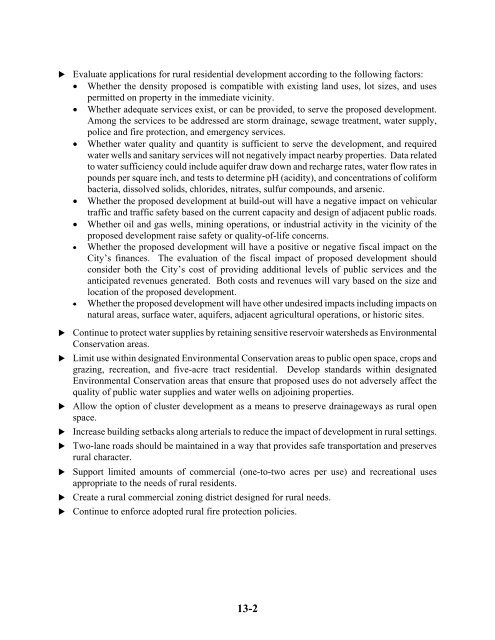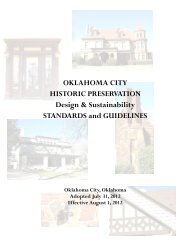OKC Plan, 2000-2020 - City of Oklahoma City
OKC Plan, 2000-2020 - City of Oklahoma City
OKC Plan, 2000-2020 - City of Oklahoma City
Create successful ePaper yourself
Turn your PDF publications into a flip-book with our unique Google optimized e-Paper software.
Evaluate applications for rural residential development according to the following factors:<br />
• Whether the density proposed is compatible with existing land uses, lot sizes, and uses<br />
permitted on property in the immediate vicinity.<br />
• Whether adequate services exist, or can be provided, to serve the proposed development.<br />
Among the services to be addressed are storm drainage, sewage treatment, water supply,<br />
police and fire protection, and emergency services.<br />
• Whether water quality and quantity is sufficient to serve the development, and required<br />
water wells and sanitary services will not negatively impact nearby properties. Data related<br />
to water sufficiency could include aquifer draw down and recharge rates, water flow rates in<br />
pounds per square inch, and tests to determine pH (acidity), and concentrations <strong>of</strong> coliform<br />
bacteria, dissolved solids, chlorides, nitrates, sulfur compounds, and arsenic.<br />
• Whether the proposed development at build-out will have a negative impact on vehicular<br />
traffic and traffic safety based on the current capacity and design <strong>of</strong> adjacent public roads.<br />
• Whether oil and gas wells, mining operations, or industrial activity in the vicinity <strong>of</strong> the<br />
proposed development raise safety or quality-<strong>of</strong>-life concerns.<br />
• Whether the proposed development will have a positive or negative fiscal impact on the<br />
<strong>City</strong>’s finances. The evaluation <strong>of</strong> the fiscal impact <strong>of</strong> proposed development should<br />
consider both the <strong>City</strong>’s cost <strong>of</strong> providing additional levels <strong>of</strong> public services and the<br />
anticipated revenues generated. Both costs and revenues will vary based on the size and<br />
location <strong>of</strong> the proposed development.<br />
• Whether the proposed development will have other undesired impacts including impacts on<br />
natural areas, surface water, aquifers, adjacent agricultural operations, or historic sites.<br />
Continue to protect water supplies by retaining sensitive reservoir watersheds as Environmental<br />
Conservation areas.<br />
Limit use within designated Environmental Conservation areas to public open space, crops and<br />
grazing, recreation, and five-acre tract residential. Develop standards within designated<br />
Environmental Conservation areas that ensure that proposed uses do not adversely affect the<br />
quality <strong>of</strong> public water supplies and water wells on adjoining properties.<br />
Allow the option <strong>of</strong> cluster development as a means to preserve drainageways as rural open<br />
space.<br />
Increase building setbacks along arterials to reduce the impact <strong>of</strong> development in rural settings.<br />
Two-lane roads should be maintained in a way that provides safe transportation and preserves<br />
rural character.<br />
Support limited amounts <strong>of</strong> commercial (one-to-two acres per use) and recreational uses<br />
appropriate to the needs <strong>of</strong> rural residents.<br />
Create a rural commercial zoning district designed for rural needs.<br />
Continue to enforce adopted rural fire protection policies.<br />
13-2

















